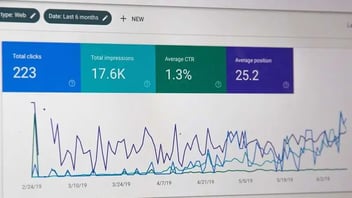How to Get More Links and Improve Your Domain Ratings
Struggling to climb the SEO ladder? Are you stuck with a low Domain Rating holding you back?
You're not alone.
But what if you could unlock the secrets to attracting high-quality links and skyrocketing your website's authority? We'll look into proven strategies for crafting link-worthy content, building valuable relationships, and watching your domain rating soar.

Why Your Domain Rating Matters
In the competitive world of Search Engine Optimization (SEO), establishing your website's authority is crucial. One key metric that reflects this authority is domain rating (DR). Simply put, DR is a score (usually on a scale of 1-100) that estimates your website's overall strength and credibility based on its backlink profile.
However, there isn't a single, universally accepted DR. Different SEO tools like Ahrefs, MOZ, and Semrush use their proprietary formulas to calculate it. While the specifics may vary, they all generally consider factors like:
-
The number of backlinks you have: More backlinks (links from other websites pointing to yours) generally indicate greater authority.
-
The quality of those backlinks: Links from high-authority websites with strong reputations carry more weight than those from low-quality or irrelevant sites.
-
The relevance of the backlinks: Links from websites in your niche or industry tend to hold more value than random ones.
Think of your website as a contestant in a popularity contest on the internet. The more popular you are (think website authority), the higher you rank in search results. That's where Domain Rating (DR) comes in–like the judge's scorecard in the SEO popularity contest. Your DR heavily influences how high your website can climb in search rankings and, consequently, how much traffic you'll attract.
When it comes to backlinks impacting your DR, you can think of them as votes of confidence – the more high-quality websites linking to you, the stronger your online reputation and the higher your DR.
-
Websites ranking in the top 10 search results typically have 3.8 times more backlinks compared to those on page two.
-
Websites with ten or more guest posts on high-authority domains have an average DR of 58, compared to just 20 for websites with no guest posts.
-
Content featuring original data and statistics is 70% more likely to be linked to by other websites.
7 Strategies to Become a Link Magnet
So, how do you get other websites to link back to you and boost your DR? Here's a hint: it's not about throwing spaghetti at the wall and hoping it sticks. It's about crafting valuable and engaging content that other websites can't resist linking to. But that's just the tip of the iceberg. Here's a roadmap to get you started:
1. Create Link-Worthy Material
In the realm of SEO, content reigns supreme. But not just any content will do. To attract backlinks and elevate your DR, you need to craft content that's so valuable and compelling other websites will naturally want to share it with their audience. So, what makes content truly link-worthy? Here are the four pillars you need to build upon:
Value and Expertise
Forget generic information readily available anywhere. Your content should address specific needs and challenges faced by your target audience. Go beyond the surface level and offer unique insights or perspectives that demonstrate your expertise in the field. Think of yourself as a trusted advisor, providing valuable solutions and empowering your readers.
Actionable and Insightful
People don't just want to read; they want to take action. Your content should be packed with practical takeaways that users can readily implement to improve their lives or businesses. Offer actionable steps, tips, and strategies that empower them to achieve their goals.
Data-driven and Well-research
Credibility is key! Back up your claims with solid evidence from reliable sources like industry reports, current statistics, or even original research you conduct. This data-driven approach adds weight to your arguments and positions you as a thought leader in your niche.
Engaging and Readable
Even the most insightful content can fall flat if it's a chore to read. Ensure your content is well-structured, with a logical flow that keeps readers engaged. Use clear, concise language that's easy to understand, even for non-experts. Don't shy away from incorporating visuals like infographics, charts, or images to break up text and enhance comprehension. Remember, you want your content to be informative but also enjoyable to consume.
2. Guest Posting
Guest posting allows you to contribute valuable insights to a highly respected website in your niche. It involves writing informative articles for other websites, typically with a link back to your relevant content. Here's why user-generated content like guest posting is a win-win for link building:
-
Increased Visibility: Reach a wider audience and establish yourself as an expert within your industry.
-
Backlink Boost: Earn a valuable backlink from a high-authority website, significantly impacting your DR.
-
Brand Recognition: Increase brand awareness and build trust with a new audience.
Tips for guest posting:
-
Identify Relevant Websites: Target websites in your niche with established audiences and high DR. Research their content themes and identify gaps you can fill.
-
Craft Compelling Pitches: Develop personalized pitches highlighting your expertise and the value you bring to their audience. Research their content style and tailor your pitch accordingly.
-
Outstanding Content is Key: Create high-quality content that aligns with the website's style and editorial standards. Ensure it's valuable, engaging, and offers a fresh perspective.
3. Broken Link Building
Ever click on a link and get a frustrating "404 Page Not Found" error? Websites are constantly evolving, and sometimes links break. This is where broken link building comes in! Here's how it works:
-
Find Broken Links: Use tools or browser extensions to identify broken links on relevant websites in your niche.
-
Identify a Replacement: Do you have existing content that's even better and more relevant than the broken link? Perfect!
-
Reach Out with a Win-Win Proposition: Contact the website owner and politely inform them about the broken link. Offer your high-quality content as a valuable replacement, ultimately benefiting both websites.
4. Networking and Outreach
Building genuine relationships with influencers and bloggers within your industry is a powerful strategy for earning valuable backlinks. Here's why:
-
Increased Credibility: An endorsement from a respected influencer adds significant weight to your brand and content.
-
Organic Backlinks: When you build genuine connections, collaborations often arise naturally, leading to backlinks within their content or social media channels.
Tips for effective outreach:
-
Identify Relevant Influencers: Research industry leaders, bloggers, and social media personalities whose audience aligns with yours.
-
Engage and Add Value: Don't just ask for something. Build relationships by genuinely engaging with their content, offering helpful insights, and participating in discussions.
-
Create Link-Worthy Collaborations: Look for opportunities to collaborate on content or projects that provide mutual benefit. This could involve co-authored blog posts, joint webinars, or even guest appearances on podcasts.
5. Create Linkable Assets
Strive to create infographics, case studies, or other visually compelling content so valuable that people can't help but share them with their network. These are linkable assets, and they're a goldmine for backlink building. Here's how:
-
High Shareability: Visually appealing and informative assets are more likely to be shared across social media and embedded on other websites, naturally generating backlinks.
-
Credibility Boost: Linkable assets showcase your expertise and data-driven approach, further establishing your brand as a thought leader.
Best practices for linkable assets:
-
Focus on Value and Insights: Don't just create something pretty – ensure your content offers valuable data, actionable takeaways, or unique perspectives.
-
High-Quality Design: Visually appealing design elements like infographics, charts, and high-resolution images enhance user engagement and shareability.
-
Branding and Call to Action: Include clear branding and a call to action that encourages others to share or link to your website.
6. Citations and Online Mentions
For local businesses, establishing a strong online presence goes beyond traditional link-building. Citations and online mentions play a crucial role in local SEO and building local authority. Here's how:
-
Accurate and Consistent NAP: NAP stands for Name, Address, and Phone Number. Ensure your business information is accurate and consistent across all online directories, review platforms, and local listings.
-
Encourage Reviews and Mentions: Positive online reviews and mentions from satisfied customers act as virtual recommendations, boosting your local SEO and online reputation.
7. Internal Linking
While backlinking is instrumental, don't forget about your own internal linking strategy. Internal linking involves strategically linking relevant pages within your website. Here's why it matters:
-
Improved User Experience: Internal linking helps users navigate your website more efficiently, discover related content, and find what they're looking for faster.
-
SEO Benefits: By strategically linking to high-quality internal pages, you distribute "link juice" (the value passed through backlinks) throughout your website, boosting the overall SEO strength of important pages.
Here are some tips for effective internal linking:
-
Contextual Links: Use relevant anchor text that naturally describes the linked page's content.
-
Link to High-Value Pages: Prioritize linking to important pages you want to rank higher in search results.
-
Link Structure: Create a logical linking hierarchy to guide users through your website's content.
By implementing these diverse link-building strategies alongside your high-quality content, you'll transform your website into a link magnet. Remember, building a strong backlink profile takes time and consistent effort. But the rewards are well worth it. Watch your domain rating soar, organic traffic climb, and your website establish itself as a trusted authority within your niche.
Build Your Domain Rating and Dominate SERPs
The rewards of a strong domain rating are undeniable. Improved search engine rankings translate to increased website traffic, which ultimately leads to more leads, conversions, and business growth. A high DR signals to search engines and potential customers that your website is a trusted authority within your niche.
But remember, building a strong domain rating isn't a sprint; it's a marathon. Consistent effort is crucial. Regularly publish high-quality, valuable content that keeps your audience engaged and attracts new visitors. Don't neglect your link-building efforts – continuously explore opportunities for guest posting, broken link building, influencer outreach, and creating linkable assets.
Here's an additional tip: monitor your backlink profile using tools like Ahrefs, MOZ, and Semrush. This allows you to identify low-quality backlinks that may be hurting your DR and prioritize acquiring high-quality links from relevant websites. By consistently creating valuable content, building high-quality backlinks, and monitoring your progress, you'll witness your domain rating steadily climb over time.
Ready to unlock the true potential of your website? Explore Aspiration Marketing's SEO services and let us help you achieve long-term SEO success.
This content is also available in:
- German: Wie Sie mehr Links erhalten und Ihr Domain-Rating verbessern
- Spanish: Cómo conseguir más enlaces y mejorar la calificación de su dominio
- French: Obtenir plus de liens et améliorer l'évaluation de votre domaine
- Italian: Come ottenere più link e migliorare le valutazioni del dominio
- Romanian: Obțineți mai multe linkuri și îmbunătățiți ratingul domeniului
- Chinese: 如何获取更多链接并提高域名评级

Joachim is a certified HubSpot trainer with over 13 years of experience in content marketing, strategy, website development, and SEO. He has implemented numerous large-scale, international growth marketing programs, including one with UiPath, which grew from a startup to a successful IPO on the NYSE. Joachim has special expertise in multilingual marketing and sales enablement projects, and he uses the latest AI technologies to help our clients.








Leave a Comment